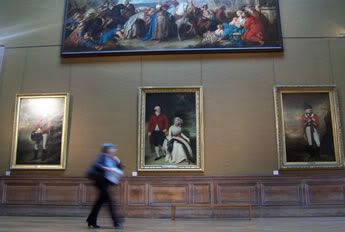
Is there a more famous museum in the world than the Louvre? Not that I know of - and despite this being my fifth trip to Paris, I'd never actually been inside. Today was another dull grey morning, perfect for indoor things, so after a quick Metro trip into the city we found ourselves walking through the blustery Jardin de Tuileries towards the famous glass pyramids. The original Palais de Louvre was constructed in 1190 by Philippe-Auguste as a place to store his weapons, but it wasn't until 1360 that a king (Charles V) decided to live in the Palace. Eventually art was stored there, and it opened as an art gallery in 1793, the same year Louis XVI met his untimely and painful end. It also proved a convenient place for Napoleon to store his massive amounts of war booty, so the collection grew and grew.
Today it houses hundreds of thousands of paintings, sculpture, relics and artefacts from all over the world (which was news to me - I thought it was just paintings). To get in, you join a queue to descend an escalator for a cursory bag check, and then line up to pay your €8.50 - not a bad price when you think about it. The Museum is laid out over three enormous wings - Denon, Richelieu, and Sully. Just standing in the foyer gives you an idea of which is the most popular - Denon - because of one very special painting.
If the Louvre is the most famous museum in the world, then the Mona Lisa is without doubt the most famous painting, and of course the Louvre's star attraction. We were pulled along in the tide of people walking briskly past masterpiece after masterpiece when the corridor opened up and turning to the right, there she was. I had wanted to take a picture of the crowd of gawkers looking at it, but photography was strictly not allowed - ostensibly to avoid harsh flashes damaging the painting (sheltered behind a double layer of darkened bullet-proof glass), but the massed ranks of reproductions in the gift shop must have had something to do with it.
It's a beautiful painting, there's no denying it - but I wasn't blown away by the majesty of la Joconde as some are. Admittedly, I know very little about painting and art, but the other early renaissance pictures there were just as impressive - it's difficult to see just what makes that particular one stand out. Still, it was nice to look at for a while, and I guess that's what paintings are all about.
After the 'large Italian artworks' we wandered through the rest of the Denon wing, and by chance found ourselves in a small gallery of indigenous art from the Pacific region - a relatively new addition to the more traditional arty stuff. They even had an Easter Island stone head. The throng of people had thinned here, but increased dramatically as we wandered along the lower Denon through classical Greek sculptures. After a slight detour through a wonderful section of Roman mosaics, we came on a long pillared corridor with the Venus de Milo at the end. I hadn't known it was in the Louvre, so we had a close look and tried to avoid getting in the way of photograph-takers. It's a stunning statue, although all I could think of was the episode of the Simpsons where Homer goes to the candy fair and ends up stealing the jelly Venus de Milo and having to run for it.
At this point, we'd been in the Louvre for hours - hours of culture and enlightenment - but still hours. Around the Egyptian antiquities section we ran out of steam. When mummies don't get your interest levels up, you know it's time to go. So in the end we'd seen barely half of the Louvre's treasures - but at least we'd knocked off the 'big two' and seen a few more interesting bits and pieces, from Roman daggers to genuine Totem poles. And here's me thinking it was just paintings...